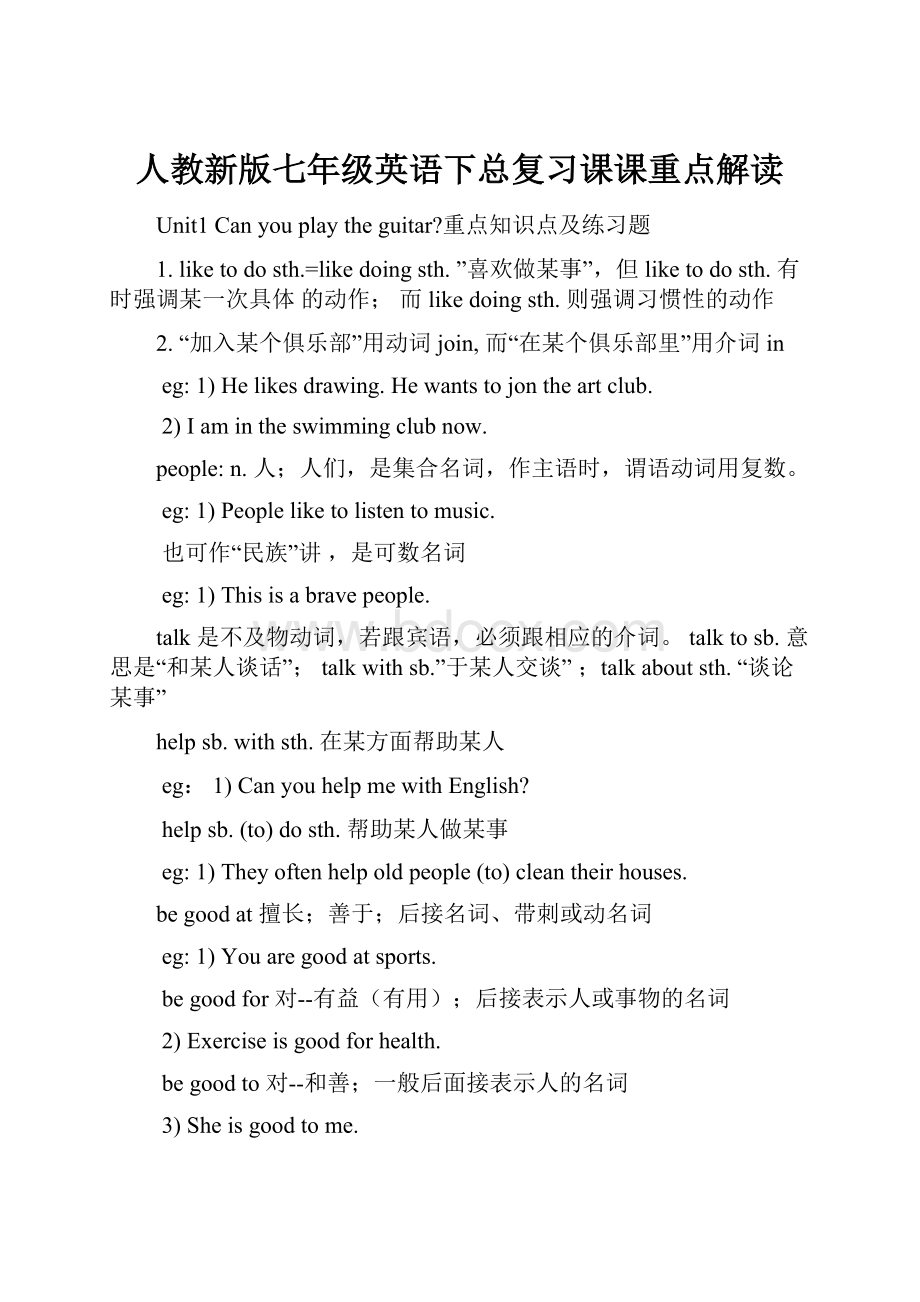人教新版七年级英语下总复习课课重点解读.docx
《人教新版七年级英语下总复习课课重点解读.docx》由会员分享,可在线阅读,更多相关《人教新版七年级英语下总复习课课重点解读.docx(27页珍藏版)》请在冰豆网上搜索。

人教新版七年级英语下总复习课课重点解读
Unit1Canyouplaytheguitar?
重点知识点及练习题
1.liketodosth.=likedoingsth.”喜欢做某事”,但liketodosth.有时强调某一次具体的动作;而likedoingsth.则强调习惯性的动作
2.“加入某个俱乐部”用动词join,而“在某个俱乐部里”用介词in
eg:
1)Helikesdrawing.Hewantstojontheartclub.
2)Iamintheswimmingclubnow.
people:
n.人;人们,是集合名词,作主语时,谓语动词用复数。
eg:
1)Peopleliketolistentomusic.
也可作“民族”讲,是可数名词
eg:
1)Thisisabravepeople.
talk是不及物动词,若跟宾语,必须跟相应的介词。
talktosb.意思是“和某人谈话”;talkwithsb.”于某人交谈”;talkaboutsth.“谈论某事”
helpsb.withsth.在某方面帮助某人
eg:
1)CanyouhelpmewithEnglish?
helpsb.(to)dosth.帮助某人做某事
eg:
1)Theyoftenhelpoldpeople(to)cleantheirhouses.
begoodat擅长;善于;后接名词、带刺或动名词
eg:
1)Youaregoodatsports.
begoodfor对--有益(有用);后接表示人或事物的名词
2)Exerciseisgoodforhealth.
begoodto对--和善;一般后面接表示人的名词
3)Sheisgoodtome.
thedaybeforyesterday;yesterday;today;tomorrow;thedayaftertomorrow;thenextday
need:
实义动词,用法:
needtodosth.
eg:
1)Heneedstostayathomeintheafternoon.
也可作为情态动词,其后跟动词原形,它多用于否定句和疑问句。
2)Needigotherenow?
----wantfor---:
“为--招聘---”
Canyouplaytheguitarorthedrums?
该句是由can引导的选择疑问句。
选择疑问句是指提问者提供两种或两种以上的情况,让对方从中作出选择的句子。
其标志是一般疑问句的形式,并且用or连接并列成分。
回答时,不能用yes/no,而是使用陈述句或其简略形式回答。
eg:
----IsthispenyoursorJack’s?
----It’sJack’s.
bein“成为----众的一员”(=beanumberof)
eg:
I’minarockband.
too;also;aswell;either这几个词都可以表示“也”,但用法不同。
1)too多用于口语,位置通常在句末,前边常有逗号。
eg:
Heisaworker,too.
2)also较正式,通常放在行为动词之前,be动词和助动词之后。
eg:
Healsoplaysthepiano.
aswell多用于口语,只用于句末。
eg:
Hecanplaytheguitaraswell.
以上三个词都不能用于否定句,否定句中用(not---)either.
eg:
Hewasnotthereeither.
13.1)wantsth.想要某物。
want后可直接跟宾语。
eg:
HewantssomeEnglishbooks.
wanttodosth.想做某事
eg:
Theywanttogotothepark.
wantsb.todosth.想要某人做某事
eg:
Doyouwantmetohelp?
语法:
情态动词can
情态动词:
有一定意义,表示说话人的语气或情态,但不能单独作谓语,只能和其他动词原形一起构成谓语,没有人称和数的变化。
否定形式是在情态动词后面加上not。
变一般疑问句要把情态动词提到句子的开头,既:
情态动词+主语+动词原形+其他?
用法:
表示能力,“会;能”。
eg:
Canyoudance?
你会跳舞吗?
表示请求或许可,“可以”。
eg:
CanIaskyouaquestion?
我可以问你一个问题吗?
表示推测和可能,“可能”。
eg:
Hecanbeathome.他可能在家里。
含情态动词can的否定句是在can后加not。
一般疑问句把can提到句首,其肯定回答为“Yes,主语+can”;否定回答为:
“No,主语+can’t”。
Unit1Canyouplaytheguitar?
单元大归纳
短语归纳
playchess下国际象棋
playtheguitar弹吉他
speakEnglish说英语
Englishclub英语俱乐部
talkto跟…说
playtheviolin拉小提琴
playthepiano弹钢琴
playthedrums敲鼓
makefriends结交朋友
dokungfu会(中国)功夫
tellstories讲故事
playgames做游戏
ontheweekends(在)周末
用法集萃
play+棋类/球类下……棋,打……球
playthe+西洋乐器弹/拉……乐器
begoodatdoingsth.=dowellindoingsth.擅长做某事
begoodwithsb.善于与某人相处
needsb.Todosth.需要某人做某事
can+动词原形能/会做某事
alittle+不可数名词一点儿……
jointhe…club加入…俱乐部
liketodosth.=lovetodosth.喜欢/喜爱做某事
典句必背
Canyoudraw?
Yes,Ican./No,Ican’t.
Whatclubdoyouwanttojoin?
Iwanttojointhechessclub.
YoucanjointheEnglishclub.
Soundsgood.
IcanspeakEnglishandIcanalsoplaysoccer.
PleasecallMrs.Millerat555-3721.
Unit2Whattimedoyougotoschool重点知识点及练习题
dresssb.(oneself)eg:
Shedressesthebaby.她给孩子穿衣服。
dress后不能接“衣服”类词作宾语。
be/getdressedin+衣服或表示颜色的词。
eg:
Theyaredressedinred.他们穿着一身红衣服
brushone’steeth
whattime所表示的时间比较精确,指“几点钟”、“几分钟”;when所表示的时间范围要比
whattime广,回答时可以用具体几点钟,也可以说哪一天,甚至哪一年。
频率副词:
always,often,sometimes,never等,提问用特殊疑问词howoften
jobcn.工作,职业eg:
Marywantsarelaxingjob.
workun.工作单位;工作;劳动eg:
MrWangusuallygoestoworkbybus.
v.工作;劳动;干活eg:
Tony’suncleworksinafactory.
exercisev.锻炼;练习
un.锻炼;运动eg:
Walkingisgoodexercise.
cn.练习;习题eg:
Ihavetodoalotofexerciseseveryday.
best----welladv.eg:
Whichskirtdoyoulikebest?
thebest----goodadj.Whoosthebeststudentinyourclass?
do做实义动词”做“,可单独做谓语。
dohomework/housework/chinesekongfu/thedishes
做助动词,无实际意义,不能单独做谓语。
eg:
Whendoyouusuallydoyourhomework?
-----Iusuallydomyhomeworkintheevening.
takeawalk=haveawalk=goforawork
either----or----或---或---;不是---就是----;是---还是----eg:
Eithersheoriamright.
neither---nor----既不是-----也不是----eg:
Neithershenoriamright.Neitherhotnorcold.
both----and----两者都----eg:
Bothsheandiareright.
lotsof=alotof
tastes尝起来
一、时间表达法:
整点时间:
“基数词+o’clock”表示,o’clock可省略。
eg:
------Whattimeisit?
------It’sfive.
非整点时间
(1)钟点数+分钟数
eg:
6:
05sixfive7:
55sevenfifty-five9:
30ninethirty
注意:
在这种形式中,15分钟不能用aquarter表示,30分钟不能用half表示。
(2)分钟数+past/to+钟点数
如果分钟数不超过30,就用“分钟数+past+钟点数”来表示。
这时15分钟可用aquarter表示,30分钟可用half表示。
eg:
2:
15aquarterpasttwo4:
30halfpastfour
如果分钟数超过30.就用“60减去分钟数+to+下一个钟点数”来表示。
eg:
9:
50tentoten10:
45aquartertoeleven
口诀:
“时”在前,“分”在后,quarter,half不能有。
如果出现past或to,我们可要看清楚;前是“分”,后是“时”,past或to立中间;past加,to是减。
如果表示“几点半”,要用halfpast加钟点。
表示时间的介词in,on和at的用法。
1.on用在具体的某日或某日的上午、下午、晚上等前。
onJuly2nd在七月二日onSunday在星期日
onthemorningofMay1st在五月一日的早晨onthemorningoflastSunday在上个星期天的早晨
2.用在早上、下午、晚上之前,或用在周、季、年、世纪等之前。
eg:
intheafternoon在下午insummer在夏天
3.at用在具体时刻之前,或用在一日中的黎明、中午、黄昏、午夜之前。
eg:
atsixo’clock在六点atnoon在正午
如果时间词前有next,this,last,every等修饰语时,常不用介词。
Unit2Whattimedoyougotoschool?
单元大归纳
短语归纳
1.whattime几点
2.gotoschool去上学
3.getup起床
4.takeashower洗淋浴
5.brushteeth刷牙
6.getto到达
7.dohomework做家庭作业
8.gotowork去上班
9.gohome回家
10.eatbreakfast吃早饭
11.getdressed穿上衣服
12.gethome到家
13.either…or…要么…要么…
14.gotobed上床睡觉
15.inthemorning/afternoon/evening在上午/下午/晚上
16.takeawalk散步
17.lotsof许多,大量
18.radiostation广播电台
19.atnight在晚上
20.belatefor迟到
用法集萃
1.at+具体时间点在几点(几分)
2.eatbreakfast/lunch/dinner吃早饭/午饭/晚饭
3.takea(n)+名词从事(……)活动
4.halfpast+基数词……点半
5.aquarterto+基数词差一刻到……点
6.from…to…从……到……
7.needtodosth需要做某事
典句必背
1.Whattimedoyouusuallygetup?
Iusuallygetupatsixthirty.
2.That’safunnytimeforbreakfast.
3.Whendostudentsuasuallyeatdinner?
Theyusuallyeatdinnerataquartertosevenintheevening.
4.Intheevening,IeitherwatchTVorplaycomputergames.
5.Attwelve,sheeatslotsoffruitandvegetablesforlunch..
6.Sheknowsit’snotgoodforher,butittastesgood.
7.Hereareyourclothes.
Unit3Howdoyougettoschool?
单元大归纳
短语归纳
1.gettoschool到达学校
2.takethesubway乘地铁
3.rideabike骑自行车
4.howfar多远
5.fromhometoschool从家到学校
6.everyday每天
7.ridethebus乘公共汽车
8.bybike骑自行车
9.busstop公共汽车站
10.thinkof认为
11.between…and…在…和…之间
12.one11-year-oldboy一个11岁的男孩
13.playwith…和…玩
14.cometrue实现
15.haveto不得不
用法集萃
1.take…to…=goto…by…乘…去…
2.Howdo/does…getto…?
…是怎样到…的?
3.Howfarisitfrom…to…?
从…到…有多远?
4.Ittakessb.sometimetodosth.做某事花费某人多长时间。
5.Howlongdoesittake…?
…花费多长时间?
6.Itis+adj.+todosth.做某事是….
7.Thanksfor+n./v.ing感谢你(做)某事。
典句必背
1.–Howdoyougettoschool?
-Iridemybike.
2.Howfarisitfromyourhometoschool?
3.Howlongdoesittakeyoutogettoschool?
4.Formanystudents,itiseasytogettoschool.
5.Thereisaverybigriverbetweentheirschoolandthevillage.
Unit4 Don’teatinclass.
Ⅰ、Usefulexpressions:
1.inclass在课堂上
2.School(Library/Family)Rules校规(图书馆规章制度/家规)
3.arrivelateforclass上课迟到
4.inthehallways在走廊里
5.intheclassrooms在教室里
6.listentomusic听音乐
7.MsClark克拉克女士
8.wearahat戴着帽子
9.listentomusicoutside在外面听音乐
10.inthemusicroom在音乐房里
11.inthedininghall在餐厅里
12.eatoutside在外边儿吃
13.sportsshoes运动鞋
14.gymclass体育课
15.therulesatyourschool学校的规章制度
16.haveto不得不;必须
17.afterschool放学后
18.gooutonschoolnights在学校行课日(有课)的晚上外出
19.toomanyrules太多规矩
20.everymorning每天早上
21.beinbed睡觉
22.byteno’clock/10:
00在十点钟之前
23.washmyclothes洗我的衣服
24.makedinner做晚餐
25.theChildren’sPalace少年宫
26.learnthepiano学钢琴
27.neverhaveanyfun从未有任何乐趣;从来都不开心
28.gotobed去睡觉
29.talkloudly大声地说话
30.rideone’sbike骑某人的自行车
31.wearahelmet戴着头盔(防护帽)
*32.somany很多;如此多的
*33.hangoutwithsb.和某人一起闲逛
Ⅱ、Sentences:
1. Whatelsedoyouhavetodo?
你还要干别的什么事?
2. LaterIhavetogototheChildren’sPalacetolearnthepiano.
然后(稍后)我必须去少年宫学钢琴。
3. Notalking!
不许讲话!
*4.You’relucky!
你好幸运啊!
Unit12Don’teatinclass.
1.肯定的祈使句:
(1)实义动词原形+其他;否定的祈使句:
(1)Don’t+实义动词+原形;
(2)be动词原形+形容词+其他;
(2)Don’tbe+形容词+其他;
(3)Letsbdosth.(3)Don’tletsbdosth
(4)No+Ving.
练:
(1)Mymothersaidtome,“Tom,_______inbed.”
A.notreadB.doesn’treadC.don’treadD.didn’tread
(2)Don’t__________(fight).=No__________(fight).
2.不要迟到:
Don’tarrivelate.=Don’tbelate.(arrive=be)
上课/上学不要迟到:
Don’tarrive(be)lateforclass/school.
3.主语省略(无主语):
Don’tarrivelateforclass.
主语不省略(有主语):
Wecan’tarrive;ateforclass.
4.在学校我们必须穿校服:
Wehavetowearuniformsatschool.
句型:
不得不/必须做某事:
havetodosth否定:
不必做某事:
don’thavetodosth
穿校服:
单数:
wearauniform复数:
wearuniforms
练:
(1)–Ican’tstopsmoking,doctor.–Foryourhealth,I’mafraidyou______.
A.canB.mayC.mustD.haveto
5.在我家里有太多的规矩:
Ihavetoomanyrulesinmyhouse.
词组:
太多…:
toomany…
6.我从来没有任何快乐:
Ineverhaveanyfun.
(never译为“从来没有”,表示否定,否定句中表示“任何,一些”,用any)
7.不要大声说话:
Don’ttalkloudly.
请大声说:
Speakloudly,please.
8.他擅长于唱歌:
Heisgoodatsinging.
句型:
擅长于做某事:
begoodatdoingsth
9.表示“地点”的词组:
(1)在教室里:
intheclassroom在课堂上:
inclass
(2)在走廊上:
inthehallways在学校里:
atschool=inschool
10.表示“时间”的词组:
(1)下课后:
afterclass放学后:
afterschool
(2)在上学的白天/晚上:
onschooldays/nights比较:
atnight
(3)到晚上10点钟之前:
by10o’clockp.m.
11.
(1)with和;如:
HelivesinBeijingwithmyparents.(不能用and)
(2)with戴着;如:
Doyouknowthefatmanwithahat?
(不能用wears)
(3)with有着;如:
It’sanoldhousewithabeautifulgarden.(不能用has)
Unit4Don’teatinclass.
单元大归纳